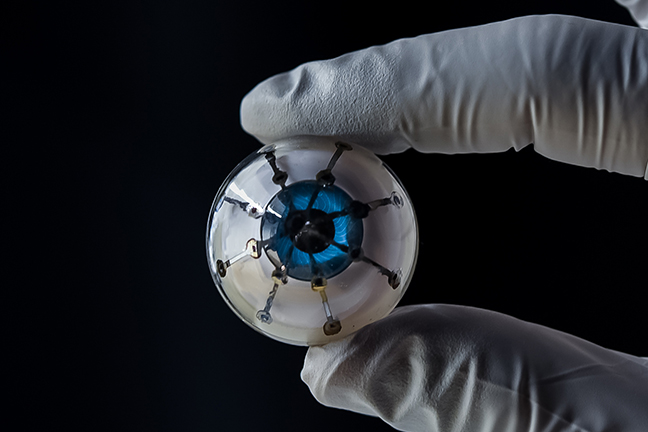
29th August 2018 A 3D-printed ‘bionic eye’ prototype A team of researchers at the University of Minnesota have, for the first time, fully 3D printed an array of light receptors on a hemispherical surface. This marks a significant step toward creating a “bionic eye” that could help blind people see – or sighted people see even better. The research is published this week in Advanced Materials, a peer-reviewed journal covering the latest in materials science. The author also holds the patent for 3D-printed semiconducting devices. “Bionic eyes are usually thought of as science fiction, but now we are closer than ever using a multimaterial 3D printer,” said Michael McAlpine, a co-author of the study and Associate Professor of Mechanical Engineering.
The team started with a hemispherical glass dome to show how they could overcome the challenge of printing electronics on a curved surface. Using their custom-built 3D printer, they started with a base ink of silver particles. The dispensed ink stayed in place and dried uniformly, instead of running down the curved surface. The researchers then used semiconducting polymer materials to print photodiodes, which convert light into electricity. The entire process took about an hour. McAlpine said the most surprising part of the process was the 25% efficiency in converting the light into electricity they achieved with the fully 3D-printed semiconductors. “We have a long way to go to routinely print active electronics reliably, but our 3D-printed semiconductors are now starting to show that they could potentially rival the efficiency of semiconducting devices fabricated in microfabrication facilities,” said McAlpine. “Plus, we can easily print a semiconducting device on a curved surface, and they can’t.” McAlpine and his team are known for integrating 3D printing, electronics, and biology on a single platform. They received international attention a few years ago for printing a “bionic ear.” Since then, they have 3D printed life-like artificial organs for surgical practice, electronic fabric that could serve as “bionic skin,” electronics directly on a moving hand, and cells and scaffolds that could help people living with spinal cord injuries regain some function. McAlpine’s drive to create a bionic eye is a little more personal: “My mother is blind in one eye, and whenever I talk about my work, she says, ‘When are you going to print me a bionic eye?’” McAlpine said. McAlpine says the next steps are to create a prototype with more light receptors that are even more efficient. His team will also research ways to print on a soft hemispherical material that can be implanted into a real eye.
Comments »
If you enjoyed this article, please consider sharing it:
|







